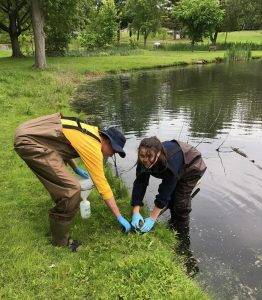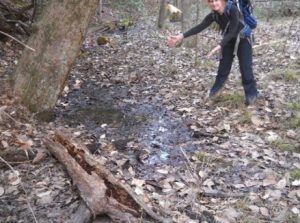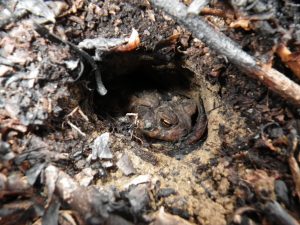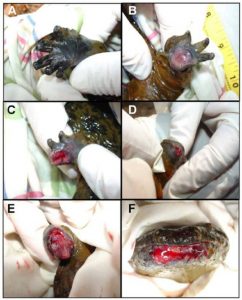Student researchers are an integral component of the Pitt Lab
- Trinity undergraduate students interested in conducting research in the Pitt Lab should send an email of interest to amber.pitt@trincoll.edu. Please indicate why you are interested in working in the lab, your major(s), relevant coursework, and anticipated career. Sophomores who are interested in continuing research in the lab throughout their time at Trinity are particularly encouraged to apply.
- Prospective graduate students interested in conducting research with the Pitt Lab should be aware that there is no graduate program in Environmental Science or Biology at Trinity College. However, Dr. Pitt can serve as a graduate student co-advisor or committee member through affiliation agreements with research universities.
- No longer a student? Postdoctoral researchers and technicians will be considered when funding is available. Opportunities for such positions will be announced on the Pitt Lab website, Trinity College job opportunities webpage, ECOLOG, and other on-line wildlife research and conservation job boards. Find additional external opportunities here.
Current Research
 Long-term changes in river turtle populations & community composition
Long-term changes in river turtle populations & community composition
Turtle populations are declining rapidly throughout the world, yet the full extent of these declines is largely unknown due to the lack of long-term datasets. We are examining long-term population trends, assemblage shifts, and habitat changes that have occurred in a river since 1969. To date, we have documented changes in population size and structure due to harvesting, as well as shifts in the turtle community composition due to habitat degradation. This research will inform turtle conservation programs and management decisions by providing insights into changes that have occurred over the past 50+ years.
Key collaborators: Dr. Max Nickerson and Joseph Tavano, M.S. (Florida Museum of Natural History-University of Florida). Funding: Saint Louis Zoo, Reptile and Amphibian Conservation Corps, and Trinity College.
 Eastern hellbender ecology in the Susquehanna River drainage
Eastern hellbender ecology in the Susquehanna River drainage
Eastern hellbenders (Cryptobranchus alleganiensis alleganiensis) are large, long-lived, aquatic salamanders that inhabit high quality, highly oxygenated, fast flowing streams and rivers in the eastern United States. Hellbender populations have undergone precipitous declines throughout their range. We are employing environmental DNA (eDNA) and mark-recapture methods for assessing the current distribution and population status of hellbenders within the Susquehanna River drainage in Pennsylvania. We are using these data along with land use/land cover data to examine relationships between land use and hellbender population and habitat status. Additionally, we are examining the relationship between hellbenders and invasive species in this region. To date, our research has revealed that water quality degradation associated with deforestation is causing hellbender population declines and extirpations. This research will inform management and conservation decisions.
Key collaborator: Steve Davis (US Fish & Wildlife Service Northeast Fishery Center). Funding: Pennsylvania Department of Conservation & Natural Resources, US Fish & Wildlife Service Northeast Fishery Center, Trout Unlimited, and Bloomsburg University.
 Urban pond ecotoxicology & wildlife habitat improvement
Urban pond ecotoxicology & wildlife habitat improvement
Urban ponds are often maintained for stormwater catchment, recreation, and aesthetic value, but they may also function as wildlife habitat. Contaminants in urban ponds may threaten wildlife populations if the contaminants decrease reproduction or survival. We are investigating trace metal concentrations and their impacts in urban pond ecosystems to better understand what factors influence trace metal concentrations and overall habitat quality for wildlife in urban ponds. We are also examining the connection between ecosystem health and human health. This research will inform urban pond management with the goal of improving wildlife habitat and the recreational and aesthetic value of urban ponds.
Funding: Trinity College.
 Snow leopard ecology in Pakistan
Snow leopard ecology in Pakistan
Snow leopards (Panthera uncia) are listed as “Vulnerable” by the IUCN and face many threats including habitat loss, hunting, retaliatory killings, and climate change. We are using trail cameras and scat data to examine snow leopard ecology and population status in Hushe, Pakistan. This research will inform snow leopard conservation efforts in this region.
Key collaborator: Dr. Shafqat Hussain (Trinity College).
Previous Research
 Bird mortality on college campuses as a result of window collisions
Bird mortality on college campuses as a result of window collisions
Migratory birds have suffered severe population declines. Window collisions continue to be a major source of mortality. We evaluated the number of bird mortality events due to collisions into campus building windows at Bloomsburg University. We also examined the impact of scavengers on the detection of window collision-based bird mortality events on campus.
This research was part of an international effort to assess the effects of college and university campuses on migratory bird populations and was conducted in collaboration with researchers from an extensive network of colleges and universities throughout North America as part of the larger Ecological Research as Education Network Bird-window Collision Project. In addition to participating in the international, collaborative research project, we evaluated the effects of Bloomsburg University buildings on migratory bird populations in order to provide data that could lead to making Bloomsburg University buildings more bird-friendly.
Key collaborators: Dr. Clay Corbin (Bloomsburg University), Stephen Hager (Augustana College), and Bradley Cosentino (Hobart and William Smith Colleges). Previous undergraduate students who conducted research on this topic include Kira England (B.S.) and Martina Drew (B.S.). Funding: Bloomsburg University.
 Isolated wetland ecology, conservation, and policy
Isolated wetland ecology, conservation, and policy
Small, isolated, and ephemeral wetlands provide a variety of critical ecological functions but are highly imperiled due to land use alterations and climate change. As a postdoctoral research fellow at Clemson University, I designed and coordinated regional, interdisciplinary, collaborative research projects to map, describe, and elucidate the ecological role of small, isolated, and ephemeral wetlands in the Piedmont and Blue Ridge ecoregions of northwestern South Carolina. This research was designed to collect data that would assist in making scientifically sound wetland management and policy decisions.
Key collaborators: Dr. Rob Baldwin (Clemson University), Dr. Bryan Brown (Virginia Tech), Dr. Alex Chow (Baruch Institute-Clemson University), Dr. Mark Scott (SC Dept. of Natural Resources), Dr. Xubiao Yu (Baruch Institute-Clemson University), Dr. Greg Yarrow (Clemson University), and Dr. John Hains (Clemson University). Former Clemson graduate students who worked on aspects of these projects as part of their degree requirements include Dr. Joanna Howard, Ben Stegenga (M.S.), Dr. Jun-Jian Wang, and Dr. Dennis Suhre. Funding: US EPA Region IV and Sustainable Forestry Initiative grants.
 Amphibian response to fire-based forest management
Amphibian response to fire-based forest management
Little is known regarding the effects of forest management techniques on amphibian movement, habitat selection, and behavior. As a postdoctoral research fellow at Clemson University, I developed and coordinated research to determine the effects of forest management techniques on American toad (Anaxyrus americanus) movement, habitat selection, behavior, and mortality in a southern Appalachian hardwood forest. This research was designed to collect data that would assist in making scientifically sound forest management decisions.
Key collaborators: Joseph Tavano, M.S. (Clemson University), Dr. Robert Baldwin (Clemson University), and Dr. Thomas Waldrop (US Forest Service-Southern Research Station). Funding: US Forest Service Southern Research Station.
 Ozark hellbender (Cryptobranchus alleganiensis bishopi) ecology and conservation
Ozark hellbender (Cryptobranchus alleganiensis bishopi) ecology and conservation
Hellbenders (Cryptobranchus alleganiensis) are imperiled throughout their range and the federally endangered Ozark subspecies (C. a. bishopi) is nearing extinction. As a research technician at the Florida Museum of Natural History, University of Florida, my collaborators and I examined habitat status in a stream that historically supported a large Ozark hellbender population in order to document changes that occurred since 1969, provide water quality data for the Saint Louis Zoo’s hellbender captive breeding program, and identify potential reintroduction sites for captive reared Ozark hellbenders. We also collaborated with researchers from Arizona State University, NASA, and the Missouri Department of Conservation to identify the microorganism community associated with Ozark hellbender limb degeneration. This research has contributed to Ozark hellbender conservation programs.
Key collaborators: Joseph Tavano, M.S. (Florida Museum of Natural History-University of Florida), Dr. Max Nickerson (Florida Museum of Natural History-University of Florida), Dr. Cheryl Nickerson (Arizona State University), Dr. Mark Ott (NASA), Dr. Jeff Briggler (Missouri Department of Conservation), and Chawna Schuette (St. Louis Zoo). Funding: Saint Louis Zoo, NASA, and the Reptile and Amphibian Conservation Corps.

